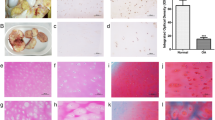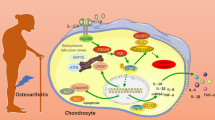Abstract
Purpose
The aim of this study was to investigate the expression of insulin-like growth factor (IGF)-1 and programmed cell death 5 (PDCD5) in osteoarthritis chondrocytes, and to explore the potential correlation between them in the apoptosis process of osteoarthritis chondrocytes.
Methods
Patients with knee osteoarthritis were placed into four categories according to radiological staging. The mRNA and protein levels of IGF-1 and PDCD5 in osteoarthritis chondrocytes were respectively detected by quantitative reverse transcriptase polymerase chain reaction (qPCR) and western blotting. In addition, IGF-1 and PDCD5 protein expression in chondrocytes were also measured by immunohistochemistry. Apoptotic cells were measured by TUNEL staining.
Results
Both the mRNA and protein levels of IGF-1 were down-regulated, while the levels of PDCD5 were up-regulated, and the mRNA and protein levels of IGF-1 were negatively correlated with those of PDCD5, respectively. The apoptotic cell was significantly increased in osteoarthritis chondrocytes compared with control. Importantly, the apoptosis rate was positively correlated with PDCD5 protein expression and negatively correlated with IGF-1 protein expression
Conclusions
We concluded that IGF-1 may down-regulate the expression of PDCD5 and thus inhibit the apoptosis of osteoarthritis chondrocytes.





Similar content being viewed by others
References
Kouri JB, Lavalle C (2006) Do chondrocytes undergo “activation” and “transdifferentiation” during the pathogenesis of osteoarthritis? A review of the ultrastructural and immunohistochemical evidence. Histol Histopathol 21(7):793–802
Spector TD, MacGregor AJ (2004) Risk factors for osteoarthritis: genetics. Osteoarthr Cartil 12:39–44
Valdes AM, Spector TD (2010) The genetic epidemiology of osteoarthritis. Curr Opin Rheumatol 22(2):139
Loeser RF (2009) Aging and osteoarthritis: the role of chondrocyte senescence and aging changes in the cartilage matrix. Osteoarthr Cartil 17(8):971–979
Almonte-Becerril M, Navarro-Garcia F, Gonzalez-Robles A, Vega-Lopez M, Lavalle C, Kouri J (2010) Cell death of chondrocytes is a combination between apoptosis and autophagy during the pathogenesis of osteoarthritis within an experimental model. Apoptosis 15(5):631–638
Blanco FJ, Guitian R, Vázquez-Martul E, de Toro FJ, Galdo F (2004) Osteoarthritis chondrocytes die by apoptosis: a possible pathway for osteoarthritis pathology. Arthritis Rheum 41(2):284–289
Musumeci G, Loreto C, Carnazza ML, Martinez G (2011) Characterization of apoptosis in articular cartilage derived from the knee joints of patients with osteoarthritis. Knee Surg Sports Traumatol Arthrosc 19(2):307–313
Chen Q, Zhang B, Yi T, Xia C (2012) Increased apoptosis in human knee osteoarthritis cartilage related to the expression of protein kinase B and protein kinase Cα in chondrocytes. Folia histochemica et cytobiologica/Polish Academy of Sciences. Polish Histochem Cytochem Soc 50(1):137
Böhm B, Hess S, Krause K, Schirner A, Ewald W, Aigner T, Burkhardt H (2010) ADAM15 exerts an antiapoptotic effect on osteoarthritic chondrocytes via up-regulation of the X-linked inhibitor of apoptosis. Arthritis Rheum 62(5):1372–1382
Liu H, Wang Y, Zhang Y, Song Q, Di C, Chen G, Tang J, Ma D (1999) TFAR19, a novel apoptosis-related gene cloned from human leukemia cell line TF-1, could enhance apoptosis of some tumor cells induced by growth factor withdrawal. Biochem Biophys Res Commun 254(1):203–210
Chen Y, Zhang Y, Sun R, Song Q, Di C, Ma D (2000) Preparation and identification of monoclonal antibodies against human apoptosis-related protein TFAR19. Zhongguo Yi Xue Ke Xue Yuan Xue Bao 22(6):502–504
Li H, Zhang X, Song X, Zhu F, Wang Q, Guo C, Liu C, Shi Y, Ma C, Wang X (2012) PDCD5 promotes cisplatin-induced apoptosis of glioma cells via activating mitochondrial apoptotic pathway. Cancer Biol Ther 13(9):822–830
Wang N, Lu HS, Guan ZP, Sun TZ, Chen YY, Ruan GR, Chen ZK, Jiang J, Bai CJ (2007) Involvement of PDCD5 in the regulation of apoptosis in fibroblast-like synoviocytes of rheumatoid arthritis. Apoptosis 12(8):1433–1441
Landin-Wllhelmsen K, Wllhelmsen L, Lappast G, Rosen T, Lindstedt G, Lundberg PA, Bengtsson BÁ (2008) Serum insulin-like growth factor I in a random population sample of men and women: relation to age, sex, smoking habits, coffee consumption and physical activity, blood pressure and concentrations of plasma lipids, fibrinogen, parathyroid hormone and osteocalcin. Clin Endocrinol 41(3):351–357
Mairet-Coello G, Tury A, DiCicco-Bloom E (2009) Insulin-like growth factor-1 promotes G1/S cell cycle progression through bidirectional regulation of cyclins and cyclin-dependent kinase inhibitors via the phosphatidylinositol 3-kinase/Akt pathway in developing rat cerebral cortex. J Neurosci 29(3):775–788
Li Y, Qin J, Lin B, Zhang W (2010) The effects of insulin-like growth factor-1 and basic fibroblast growth factor on the proliferation of chondrocytes embedded in the collagen gel using an integrated microfluidic device. Tissue Eng C Methods 16(6):1267–1275
Sheng MHC, Zhou XD, Bonewald LF, Baylink DJ, Lau KHW (2013) Disruption of the insulin-like growth factor-1 gene in osteocytes impairs developmental bone growth in mice. Bone 52(1):133–144
Arnett FC, Edworthy SM, Bloch DA, Mcshane DJ, Fries JF, Cooper NS, Healey LA, Kaplan SR, Liang MH, Luthra HS (2005) The American Rheumatism Association 1987 revised criteria for the classification of rheumatoid arthritis. Arthritis Rheum 31(3):315–324
Videan EN, Lammey ML, Lee DR (2011) Diagnosis and treatment of degenerative joint disease in a captive male chimpanzee (Pan troglodytes). J Am Assoc Lab Anim Sci 50(2):263–266
Rubenhagen R, Schuttrumpf JP, Sturmer KM, Frosch KH (2012) Interleukin-7 levels in synovial fluid increase with age and MMP-1 levels decrease with progression of osteoarthritis. Acta Orthop 83(1):59–64
Homandberg GA (2001) Cartilage damage by matrix degradation products: fibronectin fragments. Clin Orthop Relat Res 391(Suppl):S100–S107
Halstead J, Bergin D, Keenan AM, Madden J, McGonagle D (2010) Ligament and bone pathologic abnormalities more frequent in neuropathic joint disease in comparison with degenerative arthritis of the foot and ankle: implications for understanding rapidly progressive joint degeneration. Arthritis Rheum 62(8):2353–2358
Khanson KP (1997) Programmed cell death (apoptosis): molecular mechanisms and the role in biology and medicine. Vopr Med Khim 43(5):402–416
Newman AP (1998) Articular cartilage repair. Am J Sports Med 26(2):309–324
Hock JM, Centrella M, Canalis E (1988) Insulin-like growth factor I has independent effects on bone matrix formation and cell replication. Endocrinology 122(1):254–260
Fortier LA, Lust G, Mohammed HO, Nixon AJ (1999) Coordinate upregulation of cartilage matrix synthesis in fibrin cultures supplemented with exogenous insulin-like growth factor-I. J Orthop Res 17(4):467–474
Kelley KM, Johnson TR, Ilan J, Moskowitz RW (1999) Glucose regulation of the IGF response system in chondrocytes: induction of an IGF-1-resistant state. Am J Physiol 276(4 Pt 2):R1164–R1171
Maor G, Laron Z, Eshet R, Silbermann M (1993) The early postnatal development of the murine mandibular condyle is regulated by endogenous insulin-like growth factor-I. J Endocrinol 137(1):21–26
Wu S, Fadoju D, Rezvani G, De Luca F (2008) Stimulatory effects of insulin-like growth factor-I on growth plate chondrogenesis are mediated by nuclear factor-kappaB p65. J Biol Chem 283(49):34037–34044
Olashaw NE, Van Wyk JJ, Pledger WJ (1987) Control of late G0/G1 progression and protein modification by SmC/IGF I. Am J Physiol 253(4 Pt 1):C575–C579
Liu H, Wang Y, Zhang Y, Song Q, Di C, Chen G, Tang J, Ma D (1999) TFAR19, a novel apoptosis-related gene cloned from human leukemia cell line TF-1, could enhance apoptosis of some tumor cells induced by growth factor withdrawal. Biochem Biophys Res Commun 254(1):203–210
Chen Y, Sun R, Han W, Zhang Y, Song Q, Di C, Ma D (2001) Nuclear translocation of PDCD5 (TFAR19): an early signal for apoptosis? FEBS Lett 509(2):191–196
Kameda H, Ishigami H, Suzuki M, Abe T, Takeuchi T (2006) Imatinib mesylate inhibits proliferation of rheumatoid synovial fibroblast-like cells and phosphorylation of Gab adapter proteins activated by platelet-derived growth factor. Clin Exp Immunol 144(2):335–341
Pope RM (2002) Apoptosis as a therapeutic tool in rheumatoid arthritis. Nat Rev Immunol 2(7):527–535
Chen Q, Liu SQ, Du YM, Peng H, Sun LP (2006) Carboxymethyl-chitosan protects rabbit chondrocytes from interleukin-1beta-induced apoptosis. Eur J Pharmacol 541(1–2):1–8
Acknowledgements
This study was supported by National Natural Science Foundation of China(30700853).
Author information
Authors and Affiliations
Corresponding author
Rights and permissions
About this article
Cite this article
Yi, C., Ma, C., Xie, Z. et al. Down-regulation of programmed cell death 5 by insulin-like growth factor 1 in osteoarthritis chondrocytes. International Orthopaedics (SICOT) 37, 937–943 (2013). https://doi.org/10.1007/s00264-012-1744-x
Received:
Accepted:
Published:
Issue Date:
DOI: https://doi.org/10.1007/s00264-012-1744-x




